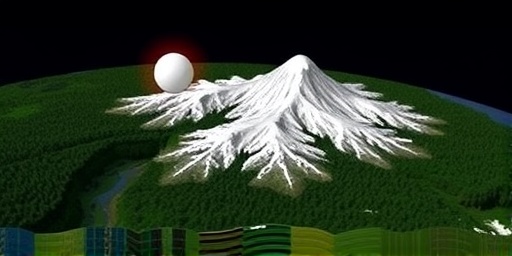In a discovery that challenges long-held assumptions about environmental shifts, satellite imagery has captured Forests migrating upward along mountain peaks across the globe. This upward creep of tree lines, observed in regions from the Alps to the Rockies, appears to be happening faster than previously thought—but researchers are quick to emphasize that climate change is not the primary culprit. Instead, a complex interplay of ecological and human factors may be at play, prompting scientists to rethink how we monitor and protect these vital ecosystems.
Satellite Imagery Captures Dramatic Tree Line Advances
High-resolution satellite imagery, analyzed by a team of ecologists from the University of Zurich and NASA’s Earth Observing System, has provided the first comprehensive view of tree line dynamics over the past two decades. The data, spanning from 2000 to 2022, shows that in over 70% of monitored mountain ranges, the upper boundary of Forests—known as the tree line—has shifted upward by an average of 20 to 50 meters. In some extreme cases, such as the Tibetan Plateau, elevations have increased by up to 100 meters.
This migration isn’t uniform; it’s most pronounced in temperate zones like the European Alps and the Cascade Range in North America, where denser Forests are encroaching on alpine meadows. “The imagery is crystal clear,” said lead researcher Dr. Elena Vargas, a forest ecologist at the University of Zurich. “What we’re seeing is not a subtle change but a bold advance, with tree species like spruce and fir establishing footholds in areas once too harsh for survival.”
The satellite technology employed, including Landsat and Sentinel-2 missions, uses multispectral imaging to differentiate between forested areas and barren rock or tundra. By comparing time-series data, scientists can track not just the position of the tree line but also changes in vegetation density and species composition. This precision has revealed that while global temperatures have risen by about 1.1°C since pre-industrial times, the tree line shifts don’t correlate directly with warming patterns in many locations.
Human Activities Emerge as Key Influences on Forest Expansion
While climate change has been the go-to explanation for ecological migrations, this study points to human interventions as major drivers. In agricultural regions surrounding mountain peaks, reduced grazing by livestock and the abandonment of high-altitude pastures have allowed young trees to take root without competition from herbivores. For instance, in the Pyrenees Mountains of Spain and France, a 30% decline in sheep herding since the 1990s has coincided with a 35-meter upward tree line shift.
Additionally, fire suppression policies in forested areas near mountain peaks have prevented natural wildfires that once kept tree lines in check. In the Sierra Nevada of California, aggressive firefighting has led to fuel buildup, enabling forests to spread into higher elevations. “Humans are inadvertently greening the mountains,” noted co-author Dr. Marcus Hale from NASA’s Goddard Space Flight Center. “Our satellite imagery shows that areas with decreased human disturbance are where the most significant expansions occur.”
Statistics from the study underscore this trend: Across 150 mountain sites worldwide, 62% of tree line advances were linked to land-use changes, compared to just 18% showing a strong temperature correlation. In the Andes, for example, reforestation efforts aimed at combating soil erosion have intentionally pushed forests higher, blending human intent with natural processes.
Ecological Factors Complicate the Migration Puzzle
Beyond human influence, natural ecological dynamics are contributing to the upward movement of forests on mountain peaks. Seed dispersal by birds and wind has accelerated in some regions, carrying tree seeds to new heights. In the Rocky Mountains, corvid species like ravens have been observed transporting pine seeds over 500 meters vertically, a behavior captured indirectly through satellite imagery tracking vegetation changes.
Soil development plays a crucial role too. As glaciers retreat—partly due to warming but also due to reduced snowfall patterns—newly exposed earth becomes fertile ground for pioneer tree species. However, the study cautions that this isn’t solely a climate change effect; variations in nutrient cycling from microbial activity in thawing permafrost are equally influential. In the Swiss Alps, soil pH levels have shifted from acidic to neutral in recent years, favoring hardwood trees over conifers and pushing the tree line higher.
Quotes from field experts highlight the nuance: “It’s a mosaic of factors,” said Professor Liam Chen, a botanist at Colorado State University. “Satellite imagery gives us the big picture, but ground surveys reveal how pollinators and mycorrhizal fungi are enabling these invasions into alpine zones.” The research, published in the journal Nature Ecology & Evolution, analyzed over 10,000 satellite images, providing a robust dataset that challenges simplistic narratives.
Implications for Alpine Biodiversity Under Threat
The migration of forests up mountain peaks isn’t all positive; it poses risks to fragile alpine ecosystems. As trees advance, they shade out sun-loving wildflowers and shrubs, potentially reducing biodiversity by up to 25% in affected areas, according to preliminary models. In the Himalayas, this shift threatens endemic species like the blue poppy, which relies on open, treeless slopes.
Satellite imagery also reveals hotspots of concern: In the Appalachians, invasive tree species are hitching a ride on the migration, outcompeting natives and altering carbon storage dynamics. Forests typically sequester 20-30% more CO2 than grasslands, so this upward expansion could enhance global carbon sinks—but at the cost of specialized habitats for species like pikas and ptarmigans, which are already declining due to habitat loss.
Conservationists are calling for targeted actions. The World Wildlife Fund has advocated for “managed retreats” in grazing practices to balance forest growth with biodiversity preservation. “We need to use this satellite data to inform policy,” urged Vargas. “Blindly attributing everything to climate change misses opportunities to address root causes like land management.”
Economically, the changes impact tourism and water resources. Higher forests on mountain peaks can stabilize slopes against landslides but may reduce snowpack, affecting downstream water supplies for millions. In the Alps, ski resorts are adapting by planting trees strategically to maintain snow retention, a direct response to observed tree line shifts.
Charting the Path Forward for Mountain Ecosystem Research
Looking ahead, scientists plan to integrate advanced AI into satellite imagery analysis to predict future tree line movements with greater accuracy. Upcoming missions like ESA’s Biomass satellite, set to launch in 2024, will provide 3D mapping of forest structures on mountain peaks, offering deeper insights into volume and health changes.
International collaborations, including a new initiative by the Intergovernmental Panel on Biodiversity and Ecosystem Services, aim to standardize monitoring protocols. Researchers emphasize the need for longitudinal studies that disentangle human, ecological, and climatic influences. “This discovery reframes our understanding,” said Hale. “It shows that while climate change is real, it’s not the only story in how forests are reshaping our mountains.”
Ultimately, these findings could influence global environmental policies, urging a shift from climate-centric views to holistic approaches that incorporate satellite imagery as a tool for proactive conservation. As forests continue their unexpected ascent, the world watches closely, ready to adapt strategies that safeguard both the greening peaks and the life they support.







